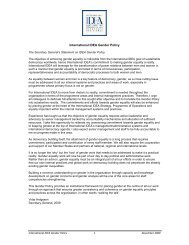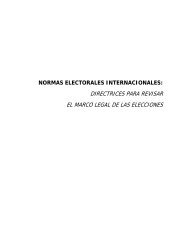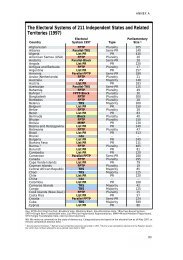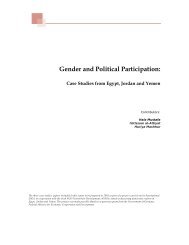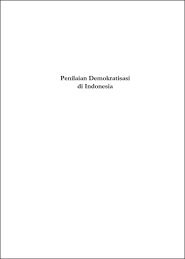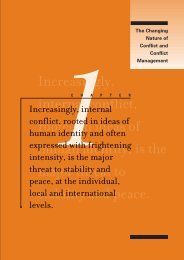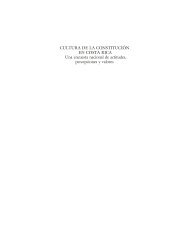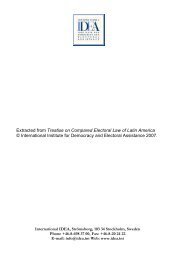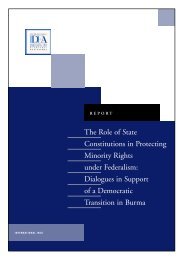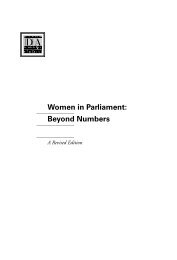Reserved Seats in South Asia: A Regional ... - International IDEA
Reserved Seats in South Asia: A Regional ... - International IDEA
Reserved Seats in South Asia: A Regional ... - International IDEA
Create successful ePaper yourself
Turn your PDF publications into a flip-book with our unique Google optimized e-Paper software.
Women <strong>in</strong> Parliament: Beyond Numbers<br />
Case Study: <strong>South</strong> <strong>Asia</strong><br />
<strong>Reserved</strong> <strong>Seats</strong> <strong>in</strong> <strong>South</strong> <strong>Asia</strong>:<br />
A <strong>Regional</strong> Perspective<br />
Shir<strong>in</strong> M. Rai<br />
The implementation of reservations, or reserved seats <strong>in</strong> a legislature for certa<strong>in</strong><br />
under-represented groups, has a relatively long history <strong>in</strong> <strong>South</strong> <strong>Asia</strong>. As early as<br />
the 1940s, India began implement<strong>in</strong>g caste-based reservations <strong>in</strong> the parliament.<br />
This case study 1 traces the evolution and current implementation of reserved seats<br />
for women primarily <strong>in</strong> the local governments of Bangladesh, India and Pakistan.<br />
National-level debates are ongo<strong>in</strong>g, and some countries have adopted quotas at the<br />
parliamentary level. However, legislation <strong>in</strong>troduc<strong>in</strong>g reservations for women <strong>in</strong> local<br />
government <strong>in</strong>stitutions has been <strong>in</strong> force for some time, generat<strong>in</strong>g empirical data<br />
on their function<strong>in</strong>g <strong>in</strong> all three countries. 2 This study also assesses the importance of<br />
reservations for enhanc<strong>in</strong>g the representation of women <strong>in</strong> political <strong>in</strong>stitutions, 3 but<br />
shows that they need to be supported by other <strong>in</strong>itiatives that address poverty and its<br />
consequences for the majority of women.<br />
The Evolution of Reservations for Women<br />
There are three dist<strong>in</strong>ct phases <strong>in</strong> the debates that have led to different provisions of<br />
reservations <strong>in</strong> the region. 4<br />
The Orig<strong>in</strong>s of Reservations<br />
Phase one was that of constitution-mak<strong>in</strong>g after the achievement of <strong>in</strong>dependence<br />
<strong>in</strong> 1947. In India, caste-based reservations were <strong>in</strong>troduced under the 9th Schedule<br />
(articles 330 and 331) 5 of the Indian Constitution <strong>in</strong> the first <strong>in</strong>stance for 50 years,<br />
but under the 62nd Amendment Act of 1989 were extended for another 40 years,<br />
demonstrat<strong>in</strong>g the political sensitivity of the removal of reservations once they<br />
have been established. However, there were no quotas for women at any level of<br />
government.<br />
174
Case Study: <strong>South</strong> <strong>Asia</strong><br />
In Pakistan, reservation of seats for women <strong>in</strong> the national and prov<strong>in</strong>cial<br />
assemblies, the Senate and local government was agreed <strong>in</strong> the first constitution<br />
of 1956, at a m<strong>in</strong>imal level of 3 percent at all levels. Women were always granted<br />
reserved seats through <strong>in</strong>direct election. The revised constitutions of 1962 and 1973<br />
also provided reserved seats for women at similarly low levels, of 2.75 percent and<br />
5 percent, respectively, <strong>in</strong> the national and prov<strong>in</strong>cial assemblies.<br />
In Bangladesh, the first constitution, promulgated <strong>in</strong> 1972, provided for 15<br />
<strong>in</strong>directly elected reserved seats for women <strong>in</strong> the national parliament for a period<br />
of ten years. This gave women a m<strong>in</strong>imum representation of 4.7 percent. Members<br />
elected to the general seats constituted the Electoral College for elect<strong>in</strong>g candidates<br />
for the reserved seats. 6<br />
The Second Phase<br />
The second phase of quota politics for women began <strong>in</strong> the 1970s and 1980s when<br />
<strong>in</strong>ternational organizations such as the United Nations highlighted the importance<br />
of women <strong>in</strong> public life through such high-profile <strong>in</strong>itiatives as the first UN<br />
Conference on Women held <strong>in</strong> Mexico <strong>in</strong> 1975 and the subsequent UN Decade for<br />
Women. Women’s groups as well as the states <strong>in</strong> <strong>South</strong> <strong>Asia</strong> were affected by these<br />
developments.<br />
In India, the first Commission on the Status of Women <strong>in</strong> India, established<br />
<strong>in</strong> 1972, recommended the constitution of statutory all-women panchayats<br />
(village councils) at the village level to promote the welfare of women, although<br />
this recommendation was not implemented by most prov<strong>in</strong>cial governments. The<br />
National Perspective Plan for Women (1988–2000) recommended the reservation of<br />
at least 30 percent of the total seats for women <strong>in</strong> the local government <strong>in</strong>stitutions.<br />
The provision of reserved seats <strong>in</strong> local government for women under the 73rd and<br />
74th amendments to the Indian Constitution was a key <strong>in</strong>itiative dur<strong>in</strong>g this phase.<br />
The Women’s National Commission was established <strong>in</strong> 1995 and has overseen the<br />
expansion of the quota system <strong>in</strong> India.<br />
In 1985 the number of reserved seats for women <strong>in</strong> the Pakistan National<br />
Assembly was raised from 2.75 percent to 10 percent for a ten-year period or three<br />
general elections, whichever came first. The Report of the Commission of Inquiry for<br />
Women (August 1997), the National Plan for Action (NPA) (September 1998) and<br />
the National Policy for Development and Empowerment of Women (March 2002)<br />
attempted to respond to Pakistan’s treaty commitments to promote women’s free,<br />
equal and full political participation. 7<br />
In Bangladesh, <strong>in</strong>ternational donor agencies, work<strong>in</strong>g with or with<strong>in</strong> the UN<br />
framework of Women <strong>in</strong> Development (WID), were <strong>in</strong>strumental <strong>in</strong> develop<strong>in</strong>g<br />
the discourse of gender equality, mobiliz<strong>in</strong>g women at the local level, and fund<strong>in</strong>g<br />
their support and tra<strong>in</strong><strong>in</strong>g. 8 The 1986 constitution did not provide for quotas but,<br />
with regard to local government <strong>in</strong>stitutions, its article 9 stated that ‘The state shall<br />
encourage local government <strong>in</strong>stitutions [to give]… special representation…as far as<br />
<strong>Reserved</strong> <strong>Seats</strong> <strong>in</strong> <strong>South</strong> <strong>Asia</strong>: A <strong>Regional</strong> Perspective<br />
175
Women <strong>in</strong> Parliament: Beyond Numbers<br />
possible to peasants, workers and women’. Reservation of seats was re-<strong>in</strong>corporated<br />
<strong>in</strong>to the constitution <strong>in</strong> 1990, valid for ten years, which expired <strong>in</strong> 2000. In May 2004,<br />
the national parliament passed the 14th constitutional amendment to re<strong>in</strong>troduce<br />
quotas for women. The number of seats <strong>in</strong> parliament is to be raised to 345, of which<br />
45 (13 percent) will be reserved for women.<br />
Current Trends<br />
The third, current, phase can be characterized by several key elements. Economic<br />
liberalization has led to the further erosion of the welfare state <strong>in</strong> India and Pakistan. 9<br />
There has also been a worldwide consensus emerg<strong>in</strong>g about the relevance of state<br />
fem<strong>in</strong>ism, especially after the Fourth World Conference on Women <strong>in</strong> Beij<strong>in</strong>g <strong>in</strong><br />
1995. This phase has seen the debate on the extension of reservations for women to<br />
the national parliament <strong>in</strong> India and the extension of quota provisions <strong>in</strong> Pakistan<br />
and Bangladesh.<br />
The systems <strong>in</strong> place <strong>in</strong> the three countries differ. In both Pakistan and Bangladesh<br />
reserved seats have been <strong>in</strong>troduced at both national and local levels, while <strong>in</strong> India<br />
they were <strong>in</strong>troduced at the local level and the bill to <strong>in</strong>troduce quotas at the national<br />
level still languishes <strong>in</strong> the parliamentary system. 10 In India there is a system of ward<br />
rotation for the reserved seats (the constituencies reserved for women are changed at<br />
every election <strong>in</strong> order to circulate the benefits of reservations geographically, although<br />
arguably this also leads to problems of cont<strong>in</strong>uity for women representatives), which<br />
is not present <strong>in</strong> Pakistan and Bangladesh. In Bangladesh the ‘wards [districts] for the<br />
reserved seats for women are three times bigger than the “general seats”. This is not<br />
the case <strong>in</strong> the other two countries. In Pakistan the union is not divided <strong>in</strong>to different<br />
wards—as <strong>in</strong> India and Bangladesh—but serve as a s<strong>in</strong>gle constituency for all the<br />
candidates’. 11<br />
However, there are also some similarities <strong>in</strong> these different quota regimes. All<br />
three countries have constitutional histories bound up with the British colonial past,<br />
have majoritarian electoral systems, and are also party-based political systems (even<br />
given the <strong>in</strong>terruptions to democratic practice <strong>in</strong> Pakistan).<br />
176
Case Study: <strong>South</strong> <strong>Asia</strong><br />
Table 14: Types of Quota <strong>in</strong> Bangladesh, India and Pakistan<br />
Country % Women <strong>in</strong> Quota Provision Electoral System<br />
Lower House<br />
National Level<br />
National Local<br />
Bangladesh 2.0 45 out of 345 seats At least 25% of seats First Past The Post<br />
(2001 election) (13%) are reserved are reserved for (plurality system)<br />
for women (2004 women <strong>in</strong> union<br />
constitutional councils<br />
amendment) (1996 legislation)<br />
India 8.3 N/A Not less than 33% First Past The Post<br />
(2004 election) women and other (plurality system)<br />
marg<strong>in</strong>alized sections<br />
of society <strong>in</strong> all local<br />
bodies (1992 constitutional<br />
amendment)<br />
Pakistan 21.1 60 of the 342 (17%) 33% of the seats are Parallel Mixed<br />
(2002 election) seats <strong>in</strong> the National reserved for women System (First Past<br />
Assembly are <strong>in</strong> legislative councils The Post comb<strong>in</strong>ed<br />
reserved for women at the union, tehsil with lists)<br />
(2002 legislation) (municipality) and<br />
district level (2000<br />
Devolution of Power Plan)<br />
<strong>Reserved</strong> <strong>Seats</strong> <strong>in</strong> <strong>South</strong> <strong>Asia</strong>: A <strong>Regional</strong> Perspective<br />
<strong>Reserved</strong> <strong>Seats</strong> <strong>in</strong> Local Government: How They Work<br />
Bangladesh<br />
In Bangladesh, urban local government is composed of two tiers: (a) pourshavas (90<br />
municipal bodies) where there is a provision of a quota for at least three women<br />
members who are to be elected by the commissioners of the pourshava; and (b) city<br />
corporations (there are six of these). Rural local government is composed of four<br />
types of parishad (council)—zila (district), upazila (a subdivision of a district), union<br />
and village. Although women have the right to vote as well as to stand for election <strong>in</strong><br />
these local bodies, dur<strong>in</strong>g the last decade few women have been successful <strong>in</strong> w<strong>in</strong>n<strong>in</strong>g<br />
seats. In 1993, direct election of reserved seats for women <strong>in</strong> the union parishad was<br />
provided for <strong>in</strong> legislation by the Parliament. Article 9 of the constitution, under<br />
‘Fundamental Pr<strong>in</strong>ciples of State Policy’, stipulates the representation of women <strong>in</strong><br />
local government <strong>in</strong>stitutions. The first election to the union parishad, under the new<br />
provision, was held <strong>in</strong> 1997.<br />
177
Women <strong>in</strong> Parliament: Beyond Numbers<br />
India<br />
In India, panchayati raj <strong>in</strong>stitutions (PRIs) function at three tiers—village panchayat,<br />
block panchayat and district panchayat. The size of a panchayat depends on the<br />
population of an area and varies across the different regions from 18,000–20,000<br />
to 500–1,000. The 73rd and 74th constitutional amendment acts from 1992<br />
strengthened the role of the PRIs as well as <strong>in</strong>troduc<strong>in</strong>g reservations for women <strong>in</strong><br />
urban and rural local government. 12 The panchayats have five-year tenures, have direct<br />
elections, and must <strong>in</strong>clude not less than 33 percent reserved seats for women and<br />
other marg<strong>in</strong>alized sections of society. The election of the chairpersons of block and<br />
district parishads is <strong>in</strong>direct, with the mode of election at the village panchayat level<br />
left to the states to decide. The reservation of seats for women was done on a rotation<br />
basis, which means that those seats that were reserved <strong>in</strong> the first term were ‘dereserved’<br />
<strong>in</strong> the second term, thus caus<strong>in</strong>g discont<strong>in</strong>uities for women representatives,<br />
their development of experience and their build<strong>in</strong>g up a power base.<br />
Pakistan<br />
In Pakistan the military regime of Pervez Musharraf adopted the Devolution of Power<br />
Plan <strong>in</strong> 2000 to establish an identical set-up of local government bodies <strong>in</strong> all four<br />
prov<strong>in</strong>ces of Pakistan. This guaranteed a 33 percent quota for women at all three<br />
levels of the local government—zila councils (district level), tehsil councils (subdistrict<br />
level) and union councils (village level). Members of the union councils are<br />
elected directly but the tehsil and zila council members are elected <strong>in</strong>directly by an<br />
electoral college formed by the elected councillors on the union councils. The union<br />
council covers between eight and ten villages. It is composed of 21 members—one<br />
nazim (chairman), one naib nazim (vice-chairman), eight general Muslim seats, four<br />
women Muslim seats, four Muslim peasant/worker seats, two women peasant/worker<br />
seats and one religious m<strong>in</strong>ority seat. This means that six out of 21 seats are reserved<br />
for women. Thus the actual quota percentage is 29 percent and not 33 percent, which<br />
is the figure that is usually quoted. This is due to the fact that there were no quotas<br />
allocated for the nazims or the m<strong>in</strong>ority seats. 13<br />
Quotas <strong>in</strong> Practice: Do they Make a Difference?<br />
The impact of reserved seats has been varied <strong>in</strong> the three countries, be<strong>in</strong>g <strong>in</strong>fluenced<br />
by the requirements of the law, process and outcome, and <strong>in</strong>dividual experiences with<br />
implementation. While the reserved seats have guaranteed women’s access to local<br />
government, albeit <strong>in</strong> relatively low numbers, it is debatable whether quotas have<br />
really addressed the issue of women’s empowerment <strong>in</strong> the countries concerned.<br />
Impact of Quotas on Local Government<br />
Arguably, one of the <strong>in</strong>dicators of the success of the reserved seats is that women’s<br />
presence has <strong>in</strong>creased with<strong>in</strong> local government and is result<strong>in</strong>g <strong>in</strong> their greater<br />
178
Case Study: <strong>South</strong> <strong>Asia</strong><br />
participation <strong>in</strong> the work of the local bodies. As a result of the reservations, women’s<br />
representation <strong>in</strong> local government has <strong>in</strong>creased <strong>in</strong> all three countries.<br />
In Bangladesh, <strong>in</strong> the union council elections of 1997 a total of 13,000 women<br />
candidates were elected to fill the reserved seats for women. A total of 63 women<br />
commissioners were elected <strong>in</strong> the country’s four city corporations.<br />
In India, reserved seats have allowed more than 1 million women from all strata<br />
of society to participate <strong>in</strong> decision mak<strong>in</strong>g at the grass-roots level.<br />
In Pakistan after 1979, local government elections were held <strong>in</strong> 1983, 1987, 1992<br />
and 2001. The local government elections of 2000–2001 brought 42,049 women<br />
<strong>in</strong>to local government.<br />
There is some evidence of the qualitative impact that women representatives<br />
are mak<strong>in</strong>g at the local level. In India women representatives are work<strong>in</strong>g better <strong>in</strong><br />
those areas where they have been successful <strong>in</strong> micro-credit programmes, literacy<br />
campaigns or other social movements. 14 In Bangladesh the direct election of women<br />
to local bodies has raised questions about the terms of reference and spheres of<br />
activity of these bodies, as well as the need for cont<strong>in</strong>u<strong>in</strong>g tra<strong>in</strong><strong>in</strong>g programmes. 15<br />
In Pakistan, women electors belong<strong>in</strong>g to the poor strata of society are approach<strong>in</strong>g<br />
female councillors as they are accessible and have p<strong>in</strong>ned their hopes of solv<strong>in</strong>g their<br />
problems on the female councillors.<br />
<strong>Reserved</strong> <strong>Seats</strong> <strong>in</strong> <strong>South</strong> <strong>Asia</strong>: A <strong>Regional</strong> Perspective<br />
The Experience of Women <strong>in</strong> Local Government<br />
The experience of women <strong>in</strong> local government <strong>in</strong> <strong>South</strong> <strong>Asia</strong> is mediated by gender<br />
and class regimes, the type of local <strong>in</strong>stitutions, formal and <strong>in</strong>formal networks, and<br />
customary laws that <strong>in</strong>fluence women’s full participation <strong>in</strong> local government. Their<br />
participation can also be affected by a lack of education, tra<strong>in</strong><strong>in</strong>g and resources.<br />
Additionally, women representatives’ dependence on male members of the household<br />
and their <strong>in</strong>ability to access economic resources (there are, for example, no salaries<br />
for local government representatives) also affect their performance. The follow<strong>in</strong>g<br />
examples illustrate the particular experiences of women at the local level.<br />
In Bangladesh, women commissioners have been restricted from perform<strong>in</strong>g<br />
four major duties: the registration of births and deaths and the issu<strong>in</strong>g of various<br />
certificates, <strong>in</strong>clud<strong>in</strong>g for nationality and character; exam<strong>in</strong><strong>in</strong>g the designs of<br />
build<strong>in</strong>gs; assist<strong>in</strong>g <strong>in</strong> census and all other demographic surveys; and monitor<strong>in</strong>g<br />
law and order. 16 Women commissioners of city corporations and municipalities have<br />
been entrusted with responsibilities relat<strong>in</strong>g only to the prevention of women and<br />
child repression, while the male commissioners play the lead<strong>in</strong>g role <strong>in</strong> perform<strong>in</strong>g<br />
all other duties. In addition, the government is yet to f<strong>in</strong>alize the remuneration for<br />
the women commissioners, and above all they do not have access to facilities such as<br />
specific office space, transport and other facilities.<br />
In Pakistan, there are frequent compla<strong>in</strong>ts by women councillors that they do not<br />
receive <strong>in</strong>vitations to council meet<strong>in</strong>gs, and less than 50 percent of women councillors<br />
attended only one meet<strong>in</strong>g where the election of chairman took place. Often papers<br />
179
Women <strong>in</strong> Parliament: Beyond Numbers<br />
are sent to their houses for their signature or thumb impression without women be<strong>in</strong>g<br />
consulted on development plann<strong>in</strong>g at the district and union council levels. Nor<br />
are they given an equal share of development funds, as women are often perceived<br />
as hav<strong>in</strong>g no direct constituency to represent. Nearly all the women who stood for<br />
election after the <strong>in</strong>troduction of quotas <strong>in</strong> 2000 did so because their male relatives or<br />
members of the community put their names forward for the position. This obviously<br />
underm<strong>in</strong>es their position as <strong>in</strong>dependent actors <strong>in</strong> local government.<br />
In India, successful self-help groups have boosted the self-image of women<br />
representatives <strong>in</strong> the villages: social mobilization has been one of the important byproducts<br />
of the quotas for women. 17 However, there is cont<strong>in</strong>u<strong>in</strong>g concern about the<br />
<strong>in</strong>fluence of male relatives over women representatives (the biwi brigade or the ‘proxy<br />
women’ discourse).<br />
Challenges to Effective Participation<br />
This section reviews some of the key challenges fac<strong>in</strong>g women <strong>in</strong> local governments<br />
<strong>in</strong> <strong>South</strong> <strong>Asia</strong>.<br />
1. Constituency representation. In Bangladesh, ‘Women members at the local bodies<br />
are not aware of their role and functions as a member of the Councils. Even most of<br />
the women voters do not know who their representatives are <strong>in</strong> the city corporations<br />
and what their actual functions are’. Accord<strong>in</strong>g to a study on the last union parishad<br />
polls held <strong>in</strong> 2003, several women were <strong>in</strong>terested <strong>in</strong> compet<strong>in</strong>g for the general seats<br />
<strong>in</strong>stead of the reserved seats. 18 This may illustrate that they see themselves as be<strong>in</strong>g<br />
empowered by the quota system to be able to aspire to the general seats, or it may<br />
highlight the problem of lack of constituency representation for women who are<br />
elected through a quota. One of the important issues that face both women and<br />
men is that central government control over resources underm<strong>in</strong>es their autonomy.<br />
Women candidates also face the hurdles of money-based politics, issues of security<br />
as they travel over large constituencies, and the cont<strong>in</strong>u<strong>in</strong>g <strong>in</strong>fluence of patriarchal<br />
social relations, which support segregation and purdah, limit<strong>in</strong>g women’s ability to<br />
participate fully <strong>in</strong> the political life of the local community.<br />
2. Relative <strong>in</strong>fluence at the local level. In India, women are expected to adjust to<br />
the imperatives of party structures for their political survival. One of the structural<br />
challenges is the weak position of the panchayats vis-à-vis the state government, which<br />
erodes the autonomy of the panchayats and those who are elected to them. Several<br />
women have po<strong>in</strong>ted out that without a proper salary 19 the panchayat is more open to<br />
corrupt practices and to be<strong>in</strong>g dom<strong>in</strong>ated by upper-class <strong>in</strong>dividuals who can afford<br />
not to be paid. So, <strong>in</strong> terms of process, the <strong>in</strong>duction of women <strong>in</strong>to politics requires<br />
attention to the expectations of members, their tra<strong>in</strong><strong>in</strong>g and remuneration issues.<br />
3. Who do women represent? In Pakistan women representatives are struggl<strong>in</strong>g to<br />
create space for themselves with<strong>in</strong> the system. A study of six districts of Punjab showed<br />
180
Case Study: <strong>South</strong> <strong>Asia</strong><br />
that women councillors had extremely limited knowledge and <strong>in</strong>formation about the<br />
powers and functions of local government. 20 They are confront<strong>in</strong>g the traditional<br />
m<strong>in</strong>dset where their male colleagues reject them as equal partners <strong>in</strong> politics. They are<br />
seen as represent<strong>in</strong>g only women and they are given responsibilities related to genderspecific<br />
projects and programmes. Councillors who were elected <strong>in</strong> reserved seats<br />
were not offered any honorarium, while it is difficult for women councillors to meet<br />
transport costs out of their own pocket, as most of them are economically dependent<br />
on the male members of their families.<br />
Differences among women (as among men) on the basis of class, caste, religion<br />
and ethnicity are played out <strong>in</strong> different ways <strong>in</strong> the representative and party politics<br />
of the three countries. In Bangladesh, most of the elected women are elite women <strong>in</strong><br />
terms of both class and education. 21 In India, while there is a considerable presence<br />
of poor farmers and agricultural labourers with<strong>in</strong> the panchayat membership, Buch<br />
po<strong>in</strong>ts out that the sarpanch (chairpersons) of panchayats are of higher class. 22 In<br />
Pakistan, nearly three-quarters of women councillors were illiterate and the majority<br />
were from a rural background. 23 The challenge here is to democratize the processes of<br />
selection for both men and women <strong>in</strong> such a way that class and caste do not play such<br />
a critical role <strong>in</strong> the selection of candidates, although the deep <strong>in</strong>equalities affect<strong>in</strong>g<br />
the region will militate aga<strong>in</strong>st this.<br />
<strong>Reserved</strong> <strong>Seats</strong> <strong>in</strong> <strong>South</strong> <strong>Asia</strong>: A <strong>Regional</strong> Perspective<br />
Conclusion<br />
This case study, focus<strong>in</strong>g on Bangladesh, India and Pakistan, suggests that reserved<br />
seats have <strong>in</strong>deed addressed issues of the under-representation of women, as <strong>in</strong>creas<strong>in</strong>g<br />
numbers are jo<strong>in</strong><strong>in</strong>g local government <strong>in</strong>stitutions. There is some evidence that their<br />
<strong>in</strong>volvement may lead to an <strong>in</strong>creased participation of women <strong>in</strong> prov<strong>in</strong>cial and<br />
national-level politics. We have also seen that women representatives do attempt to<br />
address women’s basic needs, and are approached by women’s groups to address their<br />
problems, and there is even some evidence that on the whole women representatives<br />
are less corrupt and therefore br<strong>in</strong>g to local governance some degree of credibility <strong>in</strong><br />
the eyes of the people.<br />
However, women representatives face many challenges—structural, personal and<br />
party-political. They are often not taken seriously by their male colleagues, the level<br />
of tra<strong>in</strong><strong>in</strong>g and <strong>in</strong>formation is poor, the party bosses cont<strong>in</strong>ue to dom<strong>in</strong>ate local<br />
government, thus stymie<strong>in</strong>g women representatives’ attempts to br<strong>in</strong>g about change,<br />
and the uneven gender balance with<strong>in</strong> the family cont<strong>in</strong>ues to deter women from<br />
tak<strong>in</strong>g an <strong>in</strong>dependent stand on issues. We also see that, despite some shifts, the<br />
cont<strong>in</strong>u<strong>in</strong>g dom<strong>in</strong>ance of the middle and upper classes <strong>in</strong> local politics means that the<br />
differences between women are played out <strong>in</strong> particular ways. This means that lowcaste<br />
women f<strong>in</strong>d it difficult to represent their own communities satisfactorily, while<br />
at the same time they are unable to represent any generalized <strong>in</strong>terests of women.<br />
181
Women <strong>in</strong> Parliament: Beyond Numbers<br />
Second, because of status differentials, the risks that poor, low-caste, m<strong>in</strong>ority women<br />
take <strong>in</strong> stand<strong>in</strong>g up to dom<strong>in</strong>ant privilege <strong>in</strong>terests are very high. F<strong>in</strong>ally, the rotational<br />
reservation of seats as used <strong>in</strong> India means that women representatives jo<strong>in</strong><strong>in</strong>g politics<br />
cannot nurture their constituency over a period of time, and therefore struggle to<br />
build a base for themselves <strong>in</strong> local politics.<br />
Notes<br />
1<br />
This chapter is based on a longer paper prepared for Dahlerup, Drude (ed.). Quotas for<br />
Women Worldwide. London: Routledge.<br />
2<br />
While there has been some empirical work done on the process by which reservations<br />
for women were <strong>in</strong>troduced and implemented and on the outcome for both women<br />
representatives and local government <strong>in</strong>stitutions <strong>in</strong> each of the three countries (Buch<br />
2000, Mahtab 2003, Bari 1997: see below), this is the first comparative study on the<br />
issue.<br />
3<br />
Women <strong>in</strong> <strong>South</strong> <strong>Asia</strong> (<strong>in</strong>clud<strong>in</strong>g Nepal and Sri Lanka) occupy only 7 percent of the<br />
parliamentary seats, 9 percent of the cab<strong>in</strong>et seats, 6 percent of the positions <strong>in</strong> the<br />
judiciary and 9 percent <strong>in</strong> the civil service. United Nations Development Programme<br />
(UNDP), 2000. Human Development Report 2000. Oxford: Oxford University Press.<br />
4<br />
The first quotas were part of the British adm<strong>in</strong>istrative regime <strong>in</strong> <strong>South</strong> <strong>Asia</strong> under the<br />
Government of India Act of 1935, which established quotas for women and m<strong>in</strong>ority<br />
groups.<br />
5<br />
Article 331 stipulated a reservation of seats for the Anglo-Indian community for two years<br />
if the president thought it to be under-represented <strong>in</strong> Parliament.<br />
6<br />
Chowdhury, Najma, 2003. ‘Bangladesh’s Experience: Dependence and Marg<strong>in</strong>ality <strong>in</strong><br />
Politics’, <strong>in</strong> <strong>International</strong> <strong>IDEA</strong>. The Implementation of Quotas: <strong>Asia</strong>n Experiences. Quota<br />
Workshops Report Series. Stockholm: <strong>International</strong> <strong>IDEA</strong>, pp. 50–8.<br />
7<br />
Ali, Shaheen, 2000. ‘Law, Islam and the Women’s Movement <strong>in</strong> Pakistan’, <strong>in</strong> Shir<strong>in</strong><br />
M. Rai (ed.). <strong>International</strong> Perspectives on Gender and Democratisation. Bas<strong>in</strong>gstoke:<br />
Macmillan.<br />
8<br />
See Goetz, Anne-Marie, 1996. ‘Dis/organiz<strong>in</strong>g Gender: Women Development Agents <strong>in</strong><br />
the State and NGO Poverty-reduction Programmes <strong>in</strong> Bangladesh’, <strong>in</strong> Shir<strong>in</strong> M. Rai (ed.).<br />
Women and the State: <strong>International</strong> Perspectives. London: Taylor & Francis; Goetz, Anne-<br />
Marie (ed.), 1997. Gett<strong>in</strong>g Institutions Right for Women <strong>in</strong> Development. London: Zed<br />
Books; Kabeer, N., 1994. Reversed Realities: Gender Hierarchies <strong>in</strong> Development Thought.<br />
London: Verso; and Kabeer, N., 1995. ‘Target<strong>in</strong>g Women or Transform<strong>in</strong>g Institutions?<br />
Policy Lessons from NGO Anti-poverty Efforts’. Development and Practice. Vol. 5, no. 2,<br />
pp. 108–16.<br />
9<br />
The Human Development Index rank<strong>in</strong>gs for the three countries <strong>in</strong> 2003 are 139<br />
for Bangladesh, 127 for India and 144 for Pakistan. United Nations Development<br />
Programme (UNDP), 2003. Human Development Report 2003. Oxford: Oxford<br />
University Press.<br />
182
Case Study: <strong>South</strong> <strong>Asia</strong><br />
10<br />
Rai, S. M. and Sharma, K., 2000. ‘Democratis<strong>in</strong>g the Indian Parliament: the “Reservation<br />
for Women” Debate’, <strong>in</strong> S. M. Rai (ed.). <strong>International</strong> Perspectives on Gender and<br />
Democratisation. Bas<strong>in</strong>gstoke: Macmillan.<br />
11<br />
Frankl, Emma, 2003. ‘Quota as Empowerment: The Use of <strong>Reserved</strong> <strong>Seats</strong> <strong>in</strong> Union<br />
Parishad as an Instrument of Women’s Political Empowerment <strong>in</strong> Bangladesh’,<br />
unpublished paper, Stockholm University.<br />
12<br />
In 2000 there were 532 district panchayats, 5,912 block or tauluk panchayats and 231,630<br />
village or gram panchayats, and there are more than 3 million elected panchayati raj<br />
representatives, of whom women constitute one-third. See Ford Foundation, 2002. ‘From<br />
Public Adm<strong>in</strong>istration to Governance’. New Delhi.<br />
13<br />
Graff, I., 2003. ‘Women’s Representation <strong>in</strong> Pakistani Politics: The Quota Systems under<br />
the Musharraf Regime’. Paper presented at the <strong>International</strong> Conference on Women and<br />
Politics <strong>in</strong> <strong>Asia</strong>, Halmstad, Sweden, 6–7 June.<br />
14<br />
Buch, Nirmala, 2000. ‘Women’s Experience <strong>in</strong> New Panchayats: The Emerg<strong>in</strong>g<br />
Leadership of Rural Women’. Occasional Paper 35, Centre for Women’s Development<br />
Studies (CWDS), Delhi.<br />
15<br />
Reyes, Socorro L., 2002. ‘Quotas <strong>in</strong> Pakistan: A Case Study’. Paper prepared for a<br />
workshop hosted by <strong>International</strong> <strong>IDEA</strong>.<br />
16<br />
Mahtab, N., 2003. ‘Women <strong>in</strong> Urban Local Governance: A Bangladesh Case Study’.<br />
Paper presented at the <strong>International</strong> Conference on Women’s Quotas <strong>in</strong> Urban Local<br />
Governance: A Cross-national Comparison. New Delhi, February.<br />
17<br />
Mohanty, Bidyut, 2003. ‘Women’s Presence <strong>in</strong> Panchayats (Village Councils) <strong>in</strong> India:<br />
A New Challenge to Patriarchy’. Paper presented at the <strong>International</strong> Conference on<br />
Women and Politics <strong>in</strong> <strong>Asia</strong>, Halmstad, Sweden, 6–7 June.<br />
18<br />
Mahtab 2003, op. cit.<br />
19<br />
The remuneration varies from 10 rupees (INR) per sitt<strong>in</strong>g to 50 INR. The sarpanch can<br />
get up to 100 INR.<br />
20<br />
Bari, Farzana, 1997. ‘Discover<strong>in</strong>g Female Representatives <strong>in</strong> Local Government’,<br />
unpublished report.<br />
21<br />
Frankl 2003, op. cit., p. 42.<br />
22<br />
Buch 2000, op. cit.<br />
23<br />
Bari 1997, op. cit.<br />
<strong>Reserved</strong> <strong>Seats</strong> <strong>in</strong> <strong>South</strong> <strong>Asia</strong>: A <strong>Regional</strong> Perspective<br />
183
Women <strong>in</strong> Parliament: Beyond Numbers<br />
Further Read<strong>in</strong>g<br />
Bari, Farzana, 2004. ‘Voices of Women Councilors’. Pattan Development Organization<br />
Baxi, Upendra, 1995. ‘Emancipation as Justice: Babasaheb Ambedkar’s Legacy and Vision’,<br />
<strong>in</strong> Upendra Baxi and Bhikhu Parekh (eds). Crisis and Change <strong>in</strong> Contemporary India.<br />
London: Sage<br />
Blacklock, Cathy and Laura Macdonald, 2000. ‘Women and Citizenship <strong>in</strong> Mexico and<br />
Guatemala’, <strong>in</strong> S. Rai (ed.). <strong>International</strong> Perspectives on Gender and Democratisation.<br />
Bas<strong>in</strong>gstoke: Macmillan<br />
Bystend<strong>in</strong>zky, Jill M. (ed.), 1992. Women Transform<strong>in</strong>g Politics: Worldwide: Strategies for<br />
Empowerment. Bloom<strong>in</strong>gton and Indianapolis: Indiana University Press<br />
Chatterjee, P., 1993. ‘The Nationalist Resolution of the Women’s Question’, <strong>in</strong> K. Sangari<br />
and S. Vaid. Recast<strong>in</strong>g Women, Essays <strong>in</strong> Colonial History. New Delhi: Kali for Women<br />
Kabeer, Naila, 1999. ‘Resources, Agency, Achievements: Reflections on the Measurement of<br />
Women’s Empowerment’. Development and Change. Vol. 30, pp. 435–64<br />
Lister, Ruth, 1997. Citizenship: Fem<strong>in</strong>ist Perspectives. London: Palgrave<br />
Parpart, Jane, Shir<strong>in</strong> M. Rai and Kathleen Staudt, 2003. Reth<strong>in</strong>k<strong>in</strong>g Empowerment. London:<br />
Routledge<br />
Rai, S. M., 1997. ‘Gender and Representation: Women MPs <strong>in</strong> the Indian Parliament’, <strong>in</strong><br />
Anne-Marie Goetz (ed.). Gett<strong>in</strong>g Institutions Right for Women <strong>in</strong> Development. London:<br />
Zed Books<br />
Sharma, Kumud (no date). ‘From Representation to Presence: The Paradox of Power and<br />
Powerlessness of Women’, <strong>in</strong> PRIs, Occasional paper, CWDS<br />
184




